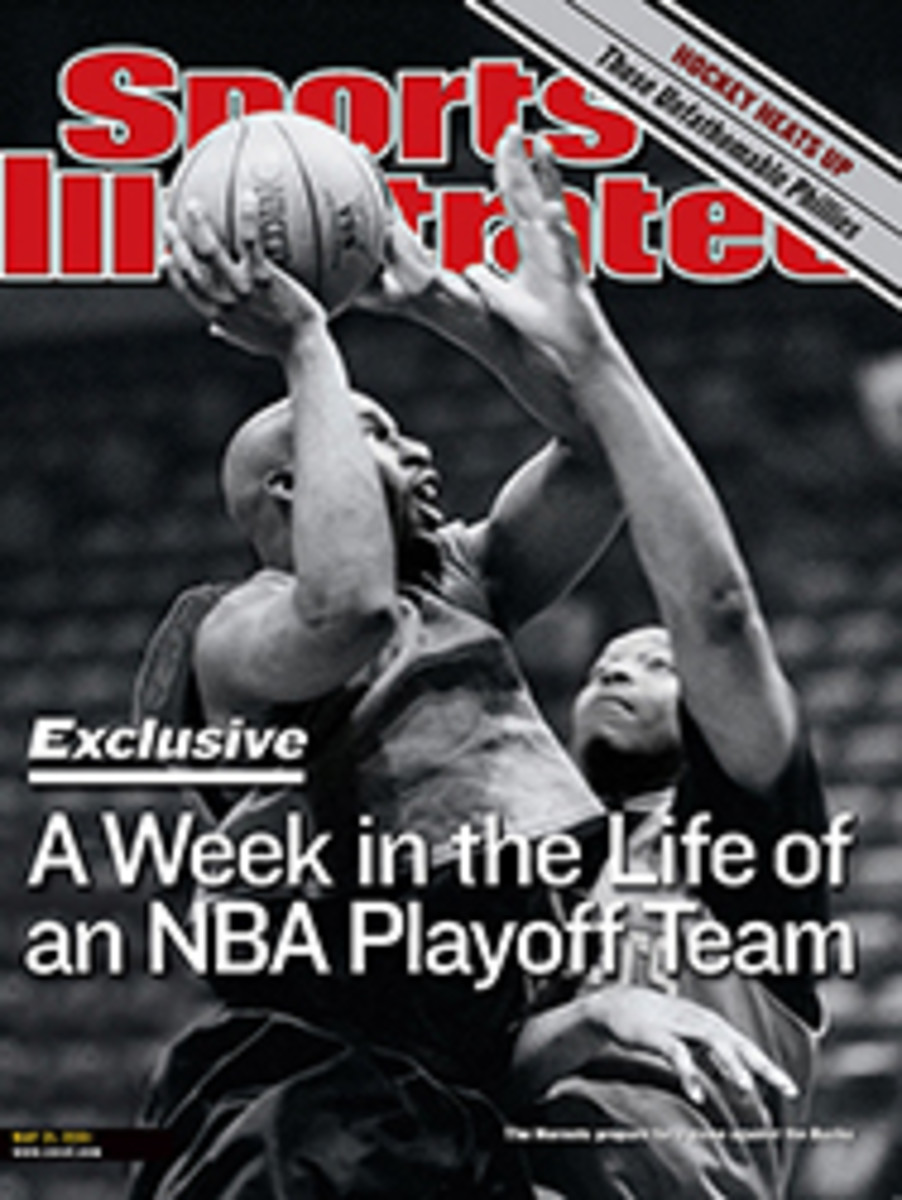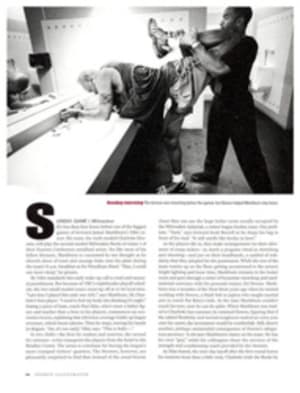
Notebook
Women's Sports Marketing
Go for Gays or Not?
The WNBA's Los Angeles Sparks created some recently by entering
into a marketing agreement with Girl Bar, a 12,000-member
nationwide lesbian social club. Conservatives decried the deal,
calling it the latest example of moral depravity, while liberals
praised the move, saying it shows that the U.S. has become more
tolerant. Abstaining from the debate was the LPGA, the
preeminent women's sports organization.
The L word has long been taboo among members of the LPGA,
founded in 1951. The organization's executives and players are
in general accord that acknowledging the presence of lesbian
golfers and fans on their tour only gives ammunition to those
who are fixated on the sexual orientation of women athletes, and
that such an acknowledgement would result in a loss of
sponsorship dollars and endorsement opportunities.
Thus LPGA commissioner Ty Votaw was in a tough spot when he was
asked if his organization would consider a marketing approach
similar to the Sparks'. "The first thing to make clear is that
we are very much an inclusive organization that markets to all
groups," Votaw said last week. "However, we're dealing with
different animals. The Sparks are a new franchise with lagging
attendance and are doing everything they can in their market.
We're a national governing body and market on a national basis,
so instead of targeting our audience with a BB gun, it's more
effective to use a shotgun approach. As far as how to market the
individual community for each tournament, that's each tournament
director's call."
Mark Hersch, director of the LPGA's Michelob Light Classic in
St. Louis, says, "We don't market to the gay and lesbian
communities, but we don't market to any particular demographic
group. I could see doing that in L.A., Palm Springs or the San
Francisco area, where alternative lifestyles are more readily
accepted."
Sandy Sachs considers Votaw's and Hersch's statements to be
disingenuous. Sachs, along with her life partner, Robin Gans,
founded Girl Bar and for 11 years helped organize Dinah Shore
Weekend, which in recent years has drawn about 5,000 lesbians to
Palm Springs for activities that include attending the LPGA's
Nabisco Championship. "When we first tried to reach the LPGA
leadership to work with us on bringing people to the Dinah, we
couldn't get them to call back," says Sachs. "The people behind
golf are mostly white-bread, Southern guys who are flat-out
stuffy and about 50 years behind the times. But the LPGA needs
the corporate dollars these guys control, so everyone in women's
golf is afraid of the word lesbian."
Sachs is all business when it comes to sexual preference and
sports. "The Sparks aren't saying that their team is lesbian or
that they're promoting lesbianism," she says. "Our deal with the
Sparks has nothing to do with the players; it has to do with the
bottom line. A lot of lesbians like sports, and their dollars are
as green as anyone else's. As much as I would like to think the
Sparks did this for social advancement, I know better. They did
it to reach a fan base that will buy tickets."
Hersch says the issue is "like Velcro" to the LPGA. "It's a
stigma that will always be associated with the tour," he says,
"but does that mean we should market to [lesbians]? I don't know."
Sachs has no such doubts. "My advice to LPGA officials is not to
worry about it so much," she says. "The LPGA's approach has been
an example of the saying, Whatever you resist, persists.
Resisting the reality has brought the LPGA negative publicity,
but if the tour looks at the Sparks thing, it will see that the
national media have put a hugely positive spin on it. People
know lesbians watch sports, and they can handle it, so let's
stop the ostrich thing. Let's get real."
World Golf League
Play--and Get Paid--like a Pro
If you're a weekend warrior who has a better shot at making a
hole in one than qualifying for a PGA Tour event but who can't
help wondering how you'd handle the fast greens, the cameras and
the putt at 18 for thousands of dollars, then the World Golf
League was made for you. The league gives men and women a shot
at playing under Tour-like conditions--with a manicured course,
scoreboards, Golf Channel coverage and a press room--and, most
important, for serious money. In 2000, the league's first year,
about 7,800 players signed up for local qualifiers and 200
reached the national tournament at Mission Inn Golf & Tennis
Resort in Howey-In-The-Hills, Fla., where winners of the four
flights, based on handicaps, earned $30,000 apiece from the
$200,000 purse. Tour pro Fulton Allen took the championship
flight.
This year World Golf League founder and CEO Mike Pagnano expects
at least 75,000 golfers to sign up. When the finals are held
November 1-3 at Ocean Ridge Plantation in Sunset Beach, N.C., he
hopes to see a total of 400 players in eight flights competing
for $1 million--$45,000 to every winner, with the next nine
finishers in each flight also cashing checks. "The money is going
to be nice," he says, "but it's really the feeling that all those
players are going to remember."
The money that makes that feeling possible comes from the $95
entry fee. A golfer can advance to regional qualifying by joining
three other World Leaguers in a foursome for 18 holes at a course
of the players' choice (low net score moves on) or by finishing
among the top 25% in a one-day qualifier at a course designated
by the league. A player can attempt to qualify as often as he or
she wants, for an additional $25 a try. Regional qualifying will
take place at about 60 courses across the U.S., with the low 400
rounds (50 players per flight) making up the field for the
national finals.
Those who qualify for the finals will lose their amateur status.
(The USGA prohibits amateurs from playing for, or accepting, a
prize worth more than $500.) "We can't keep people from forming
a commercial entity," says Marty Parkes, the USGA's senior
director of communications. "Our biggest concern is that people
know what they're getting into."
COLOR PHOTO: GABE PALACIO Sachs (right), with Girl Bar cofounder Gans, says the LPGA should follow the Sparks' lead.
COLOR PHOTO: DORIAN HANNER
COLOR PHOTO: SCOTT WHEELER
COLOR PHOTO: JOHN BARD
COLOR PHOTO: DARREN CARROLL
Trust Me
You're going to love Lanny Wadkins as a color man on this week's
telecast of the Colonial. One of the boldest in his generation,
Wadkins won't choose the safe-but-boring route in the booth
either. His grits-and-gravy voice will take getting used to,
just as Johnny Miller's high-pitched delivery did. Wadkins will
surprise you with his originality and empathy; plus, his
assertiveness and battle-hardened pith will give him a style all
his own.
Threesomes
What do these players have in common?
--Brandie Burton
--Phyllis Preuss
--Annika Sorenstam
They each won one of the three USGA championships played at Pine
Needles Lodge & Golf Club in Southern Pines, N.C., the site of
the May 31-June 3 U.S. Women's Open. Burton took the 1989 Girls'
Junior, Preuss the '91 Senior Women's Amateur and Sorenstam the
'96 Women's Open.
Feedback
Does Tiger Woods get too much airtime during tournament telecasts?
Yes 40%
No 60%
--Based on 4,314 responses to our informal survey
Next question: How would you rate Wadkins's work? Vote at
golfplus.cnnsi.com.
Numbers
This year the biggest difference between No. 1-ranked Tiger
Woods, who has three Tour victories, and No. 2 Phil Mickelson,
who has one, has been their performances on Sunday. Here are the
top six leading money winners on the PGA Tour ranked by the
difference between their average score in the final round and
their average in earlier rounds.
Earlier Rds. Final Rd. +/-
Woods 68.70 67.89 -0.81
Durant 69.47 69.36 -0.11
Love 69.43 69.50 +0.07
Calcavecchia 69.13 69.88 +0.75
Singh 68.70 70.27 +1.57
Mickelson 69.26 70.90 +1.64
Faces
Darryl Donovan, Gilroy, Calif.
Donovan, 41, the CEO of a high-tech cleaning company, won the
Alameda Commuters Tournament for the second straight year, with
a record 14-under 267. Donovan, a former pro who was reinstated
as an amateur in 1998, was comedalist at the 2000 U.S.
Mid-Amateur and the '99 Northern California Amateur champ.
Rachel Bell, East Yorkshire, England
Bell, a freshman at Florida Southern, the No. 1-ranked Division
II team, was named the Sunshine State Conference's woman
freshman and player of the year. The Moccasins' top scorer, with
a 77.0 average through Sunday, she had won two tournaments this
season, including the Sunshine State Conference Championship.
Wayne Rudzewicz, Tampa
Rudzewicz, 51, the human-resources director at a Ford
dealership, won a record sixth Tampa city championship. He shot
a two-over 146 at Rogers Park Golf Course to beat Chase Baldwin,
18, by a stroke. Rudzewicz, who has played in 23 Tampa city
tournaments and has six runner-up finishes, was champion for the
first time in 1976.
Submit Faces candidates to golfplus.cnnsi.com/faces.
JAIME'S TOP 10
Unfortunately, five-hour rounds are becoming the norm on tour,
and these poky pros (including Ted Tryba, above) are partly
responsible. At one time or another, all 10 have goaded a
playing partner into hissing, "Hit the ball, already!"--or worse.
1. BERNHARD LANGER Waiting for the then bearded Langer to clear
the green in front of him, an exasperated Lee Trevino said,
"When this round began, the man was clean-shaven."
2. TED TRYBA A bachelor who likes to look good for the ladies,
he's known to dip frequently into his bag for all manner of
personal-care products, from sunscreen to lip gloss to hair gel.
3. GRANT WAITE A swing nut who constantly checks his mechanics,
he's particularly deliberate on the greens. His unofficial
nickname: Everyone.
4. JESPER PARNEVIK Speed-walking between shots doesn't make up
for all the questions--often the same one over and over--he asks
his caddie before pulling a club.
5. CHARLES COODY It would take any pro time to hit the ball 76
times a round, as Coody does these days, but even in Coody's
heyday close friend Frank Beard said Coody was as slow as "an
old grandmother."
6. JOHN SCHROEDER Tom Kite's rant about Schroeder's pace of play
killed the Tour's miking of players. Nickname is Gucci, because
he cares more about how he looks than how he plays.
7. HUBERT GREEN He's speedy until he gets over the ball, when his
waggling looks like Anthony Mason's release on free throws.
8. MI HYUN KIM Some opponents are convinced her drawn-out
preshot routine is meant to annoy them. Then again, almost all
the Korean women are slow players. Kim is just the slowest.
9. NANCY LOPEZ Her seldom-spoken nickname is Slowpez, which she
earned in the early 1990s when she had her caddie line up all
her shots, including putts.
10. MAGGIE WILL Her campaign slogan while running for the LPGA
executive committee: "Vote for me and I'll play faster." Turns
out that was only another empty political promise.

